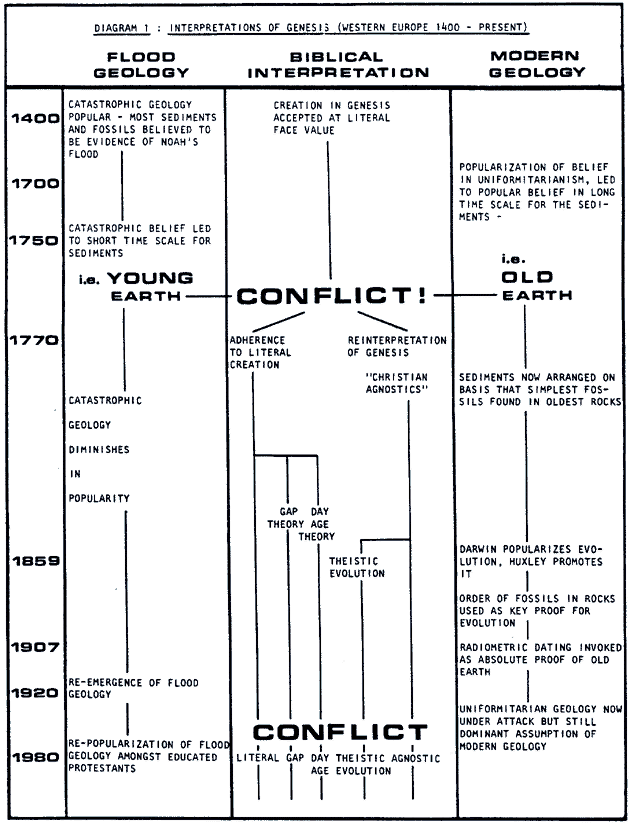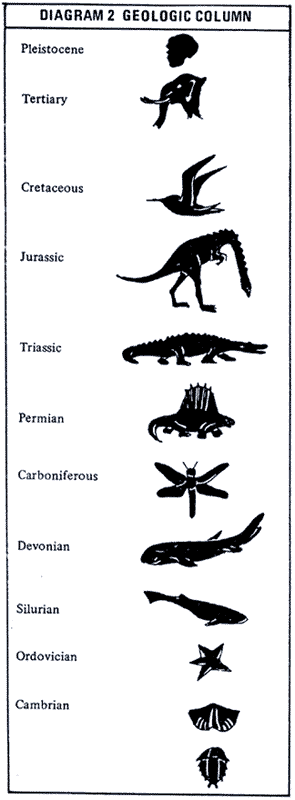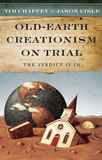The Gap Theory (Part A)
Problems and Inconsistencies
Originally published in Creation 3, no 3 (August 1980); 11-16.
There have been many attempts to harmonize or combine the Genesis account of the creation with orthodox “modern” geology—e.g. theistic evolution and progressive creation.
The gap theory is an early and significant attempt by Christian theologians to explain the apparent short scale of world history found in Genesis, in order to reduce or remove conflict with the popular belief that geologists since 1700 have provided undeniable evidence that the world is exceedingly old (currently estimated at 4.5 billion years). In W.W. Fields’ book, Unformed and Unfilled, p. 40, he writes, “One of the men who is perhaps most responsible for the origin and popularity of the gap theory is Thomas Chalmers (1780–1847), a famous theologian of Scotland, and founder of the Free Church of Scotland.”
The most academic defense of the gap theory can be found in the writings of Arthur Custance in his book Without Form and Void, (published by Arthur C. Custance, Brookville, Canada, 1970).
Currently, this “ruin-reconstruction” view is held by many who use as Bible study aids the Scofield Reference Bible or Dake’s Annotated Reference Bible. This view is also implied or allowed for in other Bibles such as The Newberry Reference Bible. Dake’s Annotated Reference Bible, p. 51, states, “When men finally agree on the age of the earth, then place the many years (over the historical 6,000) between Genesis 1:1 and 1:2, there will be no conflict between the book of Genesis and science.”
Basically, the gap concept incorporates three strands of thought:
- a belief in a “literal” view of Genesis,
- a belief in an extremely long but undefined age for the earth, and
- an obligation to explain the origin of most of the geologic strata and other geologic evidence to fit between Genesis 1:1 and 1:2.
It is only fair to say that gap theorists are opposed to evolution, but do not believe in a recent origin of all things.
Their theory is perhaps best summed up in the following way:
Genesis 1:1 In the beginning God created the Heavens and the Earth
In the far distant, dateless past, God created a perfect heaven and perfect earth. Satan was ruler of the earth which was peopled by a race of “men” without any souls. Eventually, Satan, who dwelled in a garden of Eden composed of minerals (Ezekial 28), rebelled by desiring to become like God (Isaiah 14). Because of Satan’s fall, sin entered the universe and brought on the earth God’s judgment in the form of a flood (indicated by the water of Genesis 1:2), and then a global ice-age when the light and heat from the sun were somehow removed. All the plant, animal, and human fossils upon the earth today date from this “Lucifer’s flood” and do not bear any genetic relationship with the plants, animals and fossils living upon the earth today. (Unformed and Unfilled, p. 7).
Genesis 1:2 And the Earth was without form and void. . . .
Western Biblical commentaries, written before the belief in uniformitarianism became widely accepted (1700s), and therefore before the theory of a long age for the earth became popular, postulated no gap between Genesis 1:1 and Genesis 1:2, to equate with the“ruin-reconstruction” theory. (Uniformitarian science maintains a progressive laying down of fossils throughout billions of years, and is used as a basis for the evolutionary theory). Certainly some commentaries proposed intervals of various lengths of time for reasons relating to Satan’s fall, but none ever proposed a“ruin-reconstruction” situation, or pre-Adamite world. However, with the increased acceptance of uniformitarianism, many theologians urged a reinterpretation of Genesis (see Diagram 1).
Diagram 1

The following is a brief consideration of some of the problems and inconsistencies confronting those who adhere to the gap theory:
(a) The gap theorist accepts that the earth is very old. He has based this view on the acceptance of geologic evidence which was interpreted using the assumption that the present is the key to the past. This assumption implies that fossils formed in the past at basically the same rate as they do today. It is also used by most geologists and biologists to seek to justify belief in the geologic column (i.e. the total picture of world history preserved in the rocks-see Diagram 2).
Diagram 2

This geologic column has become the showcase of evolution, because the fossils are interpreted to show “ascent“ from simple to complex forms. However, the gap theorist is committed to literal creation because of his acceptance of a “literal view” of Genesis. Hence, he finds himself in a dilemma. He cannot accept the conclusions of evolution based on the geologic column, nor can he accept that the days in the Genesis record correspond to geologic periods, so he assumes the proposition that God reshaped the earth and re-created all life in six literal days after “Lucifer’s flood,” hence the name “ruin-reconstruction.” This flood was supposedly caused by the sin of Satan, and the resulting judgment upon that sin reduced the previous world to a state “without form and void.” Now while the gap theorist may think he has solved the problem here, his solution (Lucifer’s flood) in reality has removed the reason for which he proposed the theory in the first place. If all the sediments and fossils were produced quickly in one massive worldwide flood, then the evidence that the earth is extremely old (based on the slow formation of the sediments) no longer exists.
(b) One could reasonably assume that if the world was reduced to a shapeless chaotic mass, “without form and void,” it would be difficult to imagine how an ordered assemblage of fossils and sediments could remain as evidence. Surely, one could conclude that in such a degree of chaos the fossil record would have been severely disrupted if not entirely destroyed.
(c) If we are committed to explaining the fossil record on the basis of Lucifer’s flood, then what effect did the worldwide Flood of Noah have? On this point the gap theorist is forced to conclude that Noah’s Flood left virtually no trace. Genesis however, depicts Noah’s Flood as a judgment by water for sin. It is spelled out in Scripture (Genesis 6:8). It covered the whole world (Genesis 6:17 and 7:19–24).
Some gap theorists overcome this dilemma by suggesting Noah’s Flood was only a local event.
Plants and all life that had breath suffered and died. It lasted for over a year and only one family survived (Genesis 7:23b). One can understand his difficulty in maintaining a literal acceptance of Genesis (which includes the catastrophic Noah’s Flood), while at the same time not allowing for any trace of that event. Some gap theorists overcome this dilemma by suggesting Noah’s Flood was only a local event.
(d) On the basis of Romans 5:12 “Wherefore, as by one man sin entered into the world, and death by sin; and so death passed upon all men, for that all have sinned,” it is understood that there could not have been death before Adam. There could not have been sin before Adam, as the Bible says it was through Adam that sin came into the world (Romans 5:12). But the fossil record speaks of disease, decay and death. Contrary to this teaching of Scripture, the gap theorists must accept that these three things existed before Adam sinned.
(e) The gap theorist must also choose to ignore any evidence consistent with a belief in a young age for the earth, possibly no greater than 10,000 years. There is much evidence for this—e.g. the decay of the earth’s magnetic field, the quantity of meteoric dust on the moon, the breakup of galaxy clusters, etc.
(f) Exodus 20:11 states, “For in six days the Lord made heaven and earth, the sea and all that in them is, and rested the seventh day: wherefore the Lord blessed the sabbath day, and hallowed it.” Note the emphasis, “and all that in them is.” If the fossil record was in the earth after the six days of creation and before Adam sinned (as gap theorists suppose), then God would have had to make that strata during the time limit of six days, since it is an integral part of “all that in them is”! God declared of everything He had made, in the heaven, earth and sea, that it was “very good.” How could a fossil record which gives evidence of disease, violence (fossils have been found of animals fighting each other) death, decay, etc.—be described as “very good”?
(g) The gap theory has failed to accommodate or satisfy evolutionary and uniformitarian science as its advocates hoped. By accepting a long age for the earth (based on the geologic column derived from uniformitarian geology,) the gap theorist leaves the evolutionary system intact (which by his own assumptions he opposes), and he must theorize that Romans 5:12 and Genesis 3:3 refer exclusively to spiritual death. This theory is not borne out by exegesis of Scripture (1 Corinthians 15; Genesis 3:22–23).
Conclusion
The Genesis record speaks of a catastrophe responsible for destroying all organisms that had the “breath of life in them” except for those preserved in Noah’s Ark. Christ referred to Noah’s Flood in Matthew 24:37–39. He said that just as there was once a worldwide judgment of mankind by water, so there will be another worldwide judgment (this time by fire).
It is more consistent with the whole framework of Scripture to correlate this recorded event, Noah’s Flood, with most major fossil deposits, than to resort to a vague area of Scripture such as the fall of Satan to justify a speculative geologic catastrophe which achieves nothing for Biblical understanding or science.
Sadly, Christians sometimes appear to be susceptible to what has been termed the “Thomas Aquinas Syndrome.” Thomas Aquinas, one of the early church fathers, said, “We must be on our guard against giving interpretations which are hazardous or opposed to science, and so expose the Word of God to ridicule of unbelievers.”
By interpreting the Scriptures in the light of the popular beliefs of the day, many Christians have sought to avoid persecution or intellectual conflict, rather than to accept God’s Word by faith. The gap theory appears to reinterpret Scripture to fit in with the favored scientific concepts of the day.
The Gap Theory—Problems and Inconsistencies Summary
| Gap Theory | Evolutionary Science | Comment | |
|---|---|---|---|
| —accepts geologic record and explains it by hypothetical catastrophe (Lucifer’s Flood). | |||
| As most geologic strata are explained on the basis of Lucifer’s Flood, no geological model can be built up from Noah’s Flood, i.e.; Noah’s Flood produced no fossils, etc. | —geologic column built on the basis of uniformitarian processes; little or no catastrophism. | Noah’s Flood—the only catastrophe—worldwide—that could be correlated with the fossil record. | Most of the fossil record is explained best on the basis of catastrophism. |
| The earth became “formless and void” after the catastrophe (Lucifer’s Flood) formed most of the fossil record. | —little or no catastrophism allowed. | The earth being “formless and void” was one of the early stages in the development of the earth. | Any catastrophe that left the earth “formless and void” would have destroyed any geological column or fossil record. |
| There had to be death and sin before Adam, as the whole “pre-adamite” world perished (a judgement) in Lucifer’s Flood. | —death is a necessary part of the evolutionary system: evolution requires death. | Romans 5:12—There could not have been death of man or animal before Adam. | The origin or reason for death can only be found by revelation. |
| There was a race of men without souls on the world before Adam. This race was destroyed by Lucifer’s Flood. | Man evolved from ape-like creatures 1–3 million years ago. | 1 Cor. 15:45—The Bible clearly states that Adam was the first man. | There is no evidence that man has been any different (within the limits of variation) than is now. |
| The fossil men in the fossil record are the remains of the soul-less men from the “pre-adamite” world. | Many fossil men are not found in correct evolutionary sequences. Evolutionists explain this on the basis of fossils transported by various means. | As the Flood in Noah’s day was sent as a judgement on mankind (as well as the animals), it would appear logical that many of the fossil men in the fossil record were from the people living in Noah’s day. | The evolutionist, in order to hold to the “fossil” history of man, must resort to arbitrary secondary assumption. |
Recommended Resources

Answers in Genesis is an apologetics ministry, dedicated to helping Christians defend their faith and proclaim the good news of Jesus Christ.
- Customer Service 800.778.3390
- Available Monday–Friday | 9 AM–5 PM ET
- © 2025 Answers in Genesis


